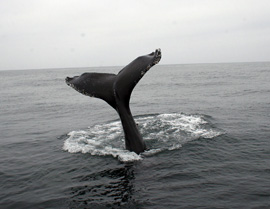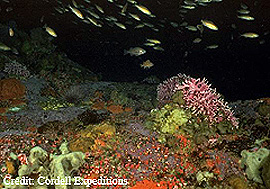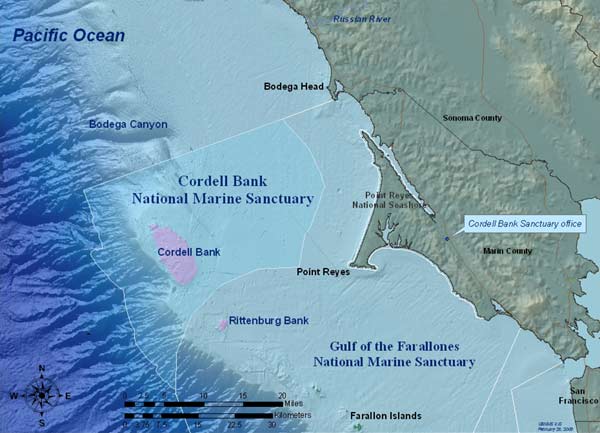Featured News
Overview
Cordell Bank National Marine Sanctuary is an extremely productive marine environment off the coast of northern California, west of Marin County. Located about 50 miles north of San Francisco, the sanctuary is entirely offshore, with the eastern boundary six miles from shore and the western boundary 30 miles offshore at the 1000 fathom depth contour. The sanctuary was designated in 1989 to provide protection and promote responsible use of this important region, including the open water and seafloor habitats and communities. The centerpiece of the sanctuary is Cordell Bank, a four and a half by nine and a half mile rocky undersea feature located 18 miles west of the Point Reyes headlands. The bank sits at the edge of the continental shelf and rises abruptly from the soft sediments of the shelf to within 115 feet of the ocean surface.
Cordell Bank is located in the California Current upwelling system, which is associated with one of the four major eastern boundary currents of the world. Coastal upwelling initiates an annual productivity cycle that supports a rich resident biological community as well as migratory populations of sea turtles, fishes, seabirds and whales that travel thousands of miles to feed around the bank. It’s the combination of a healthy benthic community on the bank in close proximity to offshore, open water species that contributes to the unique biological diversity in a relatively confined area around Cordell Bank. Cordell Bank National Marine Sanctuary comprises a diversity of habitats that harbor rich marine communities. Ocean processes, physical habitat and depth greatly influence the composition and distribution of species that inhabit the benthic and pelagic environments.
Through partnerships with state and federal agencies, and academic and research institutions, Cordell Bank National Marine Sanctuary seeks out the broader scientific community to ensure that the most effective and rigorous science can be attained. Our goal is to create sound scientific information available for resource management, monitoring, interpretation, education, planning, and policy needs.

The logistics of conducting research at Cordell Bank sanctuary can often be challenging, given the distance from shore, rough ocean conditions, complex habitat types, and depths. These factors make it necessary for researchers to use a wide variety of vessels, tools, and technology to explore, monitor, research, and manage this ocean environment.
Site characterization studies provide information on the biodiversity, habitats and resources that define the sanctuary. Projects focusing on site characterization within Cordell Bank sanctuary include benthic habitat mapping, assessment of benthic communities associated with various habitats, and a biogeographic summary to describe the distribution and relative abundance of the coastal biota and associated habitat. Large regions of the sanctuary, such as the deep-sea environments, are still poorly understood.
Sanctuary monitoring programs assess the status and condition of marine life and habitats over time. Several key monitoring programs are in place within Cordell Bank sanctuary to describe changes in the oceanic environment and pelagic and benthic communities. For example, the Cordell Bank Ocean Monitoring Program (CBOMP) characterizes and monitors the pelagic environment in the region of Cordell Bank on a

monthly basis. Data are collected on seabird, marine mammal and other vertebrate abundance and distribution as well as oceanographic conditions to understand seasonal and annual changes in the pelagic environment. The Cordell Bank oceanographic buoy is part of the National Marine Sanctuary Program’s West Coast Observation project as well as a contributor to the Central California Ocean Observing System (CeNCOOS). This buoy provides important information on local and regional conditions by collecting data on salinity, temperature, fluorescence of chlorophyll-a, turbidity, wind speed and direction, and water current speed and direction. Another important monitoring program conducted within the sanctuary focuses on the benthic community of Cordell Bank, particularly the fishes and larger invertebrates, using the manned Delta submersible to conduct transect surveys.
Research projects illuminate the natural and anthropogenic processes and relationships which affect sanctuary resources. One such project conducted by PRBO Conservation Science in partnership with Cordell Bank sanctuary examines the relationship between oceanographic conditions, krill, and krill predators (seabirds and marine mammals) and how these patterns change seasonally and between years. The non-profit organization Oikonos Ecosystem Knowledge also works cooperatively with Cordell Bank sanctuary to understand movement and habitat-use patterns of Black-footed Albatrosses that travel from Hawaii to feed in the food-rich waters of the sanctuary. Many of the research projects conducted in Cordell Bank sanctuary apply to multiple sanctuaries, demonstrating the ecological connectivity of the National Marine Sanctuary system.
The Sanctuary may provide coordination and logistical support, vessel support and limited funding for research projects addressing priority needs. Research activities may require a permit from the Sanctuary. For general information on research being conducted within the sanctuary, please contact the Cordell Bank National Marine Sanctuary Superintendent, Dan Howard (Dan.Howard@noaa.gov). For more information on operations and permitting within Cordell Bank sanctuary, please contact the Cordell Bank National Marine Sanctuary Operations Coordinator, Michael Carver (Michael.Carver@noaa.gov).



